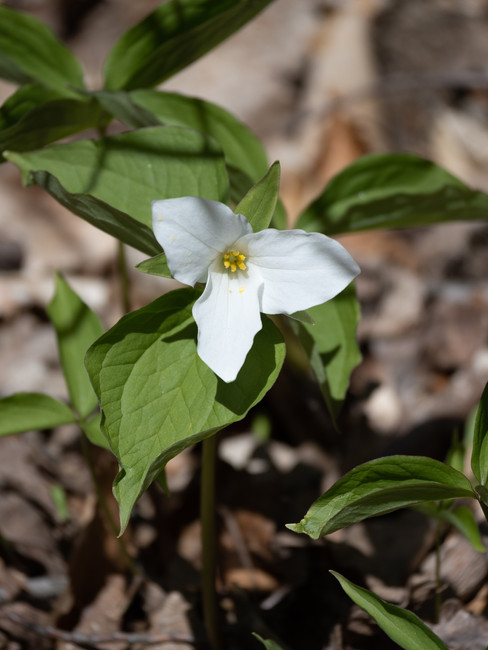Ephemeral Beauty: Spring Wildflowers at Rock Point
- Rock Point Communications
- Apr 24
- 4 min read
photos and writing by Lorna Dielentheis, local naturalist & contributing author
Spring is a season of temporality. Vernal pools, migrating birds, and budding branches together form a fleeting beauty. Formerly quiet nights are enlivened by a cacophony of singing frogs. But perhaps the most delightful sign of spring is the emergence of ephemeral wildflowers.

Spring ephemerals are aptly named: their above-ground life cycle is brief. They appear early in the season, taking advantage of the ample sunlight not yet blocked by summer’s leafy growth. Many have unique adaptations that allow them to tolerate the cooler temperatures and specific conditions of early spring. Red trillium, wild ginger, and skunk cabbage produce foul odors to attract spring pollinators, while bloodroot cleverly curls a leaf around its bloom to guard against the cold. Red columbine takes advantage of conditions that prove difficult for most other plants. Jack-in-the-pulpit possesses the ability to change its sex from year to year, depending on how much energy it's able to store up. Skunk cabbage, the earliest of the ephemerals, even generates its own heat.
The presence of ephemerals is often an indicator of nutrient-rich soils and healthy ecosystems. The calcium-rich soil and natural communities at Rock Point create ideal environments for ephemerals to thrive. Rock Point’s soil is fed by its bedrock, Dunham Dolostone, which was once an ancient sea floor. The shells of the aquatic creatures who lived in this ancient sea, buried and compressed 500 million years ago, created the bedrock that today nourishes Rock Point’s spring wildflowers.
Rock Point is home to a variety of spring ephemerals. We’ve profiled seven of them here, but there are many more to find. Come hike our trails and see which ones you discover, and check out neighboring Arms Forest for even more. Note: Please stay on the trails and refrain from picking or trampling the ephemerals. They have only this brief opportunity to reproduce, and many of them take years to establish and bloom.
Sharp-Lobed and Round Lobed Hepatica Anemone acutiloba, Anemone americana
Hepatica is one of the first spring ephemerals to bloom each spring. Named for their liver-shaped, three-lobed leaves, they thrive on the calcium-rich soil at Rock Point. There are two local species– sharp-lobed and round-lobed– referring to the shape of the leaves. The two species hybridize, so you may see Hepatica leaves anywhere along the spectrum from rounded to sharp.
Hepatica comes in a range of colors: white, purple, pink, and blue. Note the difference between the sharp-lobed and round-lobed leaves.
Large White Trillium Trillium grandiflorum
Large White Trillium is one of a few trillium species found in Vermont. They often grow in big patches, and are one of many ephemerals whose seeds are dispersed by ants. Each of the trillium’s seeds is attached to an oil-rich sac called an elaiosome, which the ants use as food. Ants carry the seed with the attached elaiosome back to their nest, effectively planting them and allowing them to germinate in a protected space. This process is called myrmecochory.
Red Trillium Trillium erectum
Red Trillium, also known as Wake Robin or Stinking Benjamin, is another species of trillium found locally. Its flower is smaller than that of Large White Trillium, and its petals are a deep red or maroon. Like a few other ephemerals, it gives off a foul odor similar to the smell of a wet dog that attracts specific pollinators, mainly flies and beetles.
large white trillium, red trillium

Yellow Trout Lily Erythronium americanum
Around the time hepaticas begin to bloom, look closely at the leaf litter and you might see the mottled, upright leaves of a trout lily colony beginning to emerge. The majority of trout lilies are produced asexually, creating large, genetically identical clonal colonies. They reproduce sexually too, but only about 10% of pollinated flowers develop seeds. An individual trout lily can take up to seven years to flower, and in any given year, only 0.5% of individuals in a colony will bloom. Those that flower develop two basal leaves, whereas those that do not will grow just a single leaf.
Bloodroot Sanguinaria canadensis
Bloodroot’s delicate white flower emerges swaddled by its lacy single leaf, each on a separate stalk. The leaf protects the flower from the cold, a unique adaptation that helps it survive the temperature variation of early spring. Bloodroot gets its name from the red fluid that seeps from the stem and rhizomes when broken, though please do not sacrifice one to confirm. Each flower lasts only a few days before dying back, but the leaf persists, growing taller and larger well into the summer.
from left to right: bloodroot's leaf and flower emerging on separate stems, bloodroot blooming, bloodroot leaves grown large in late summer

Early Meadow Rue Thalictrum dioicum
When Early Meadow Rue first rises from the bed of decaying leaves, it looks almost like a miniature bunch of purple grapes. As it grows, its delicate leaves expand and turn green, their lobed margins becoming more pronounced. Early Meadow Rue are dioecious, meaning their male and female flowers are on separate plants. The flowers of male plants feature dangling stamens, while the female flowers have wiry, tendril-like pistils. Like some other ephemerals, the leaves persist after the flowers die back.
Red Columbine Aquilegia canadensis
Red Columbine is one of the most vibrant ephemerals you’ll find in Vermont woodlands. They often grow in rocky areas, like the limestone bluffs at Rock Point. They are adapted to thin soil conditions and take advantage of places where the soil is too shallow for other plants and trees to grow. And as if their flowers weren’t showy enough, they attract one of the most striking spring pollinators: hummingbirds.

All photos © Lorna Dielentheis 2025
.png)


























Comments